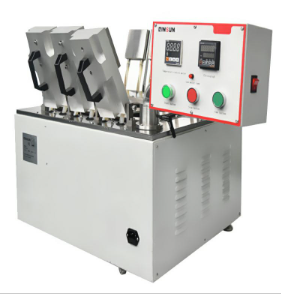- Qinsun Instruments Co., Ltd.
- Tell:+86-21-6780 0179
- Phone:+86-17740808215
- Address:No. 2578 Minhang District Gu Dai Road, Shanghai
- Contact:Mr. Li
- QQ:846490659
Atomization tester

The atomization tester simulates the process of volatilization and condensation, and evaluates the evaporation and condensation of volatile components in automotive and aircraft interior plastic parts, polyurethane, textiles, leather, adhesives, non-woven fabrics, thermoplastic elastomers, and other materials at high temperatures by measuring the weight increase of the condensate and its impact on the blurring performance of glass. It can also be used to determine the high-temperature atomization phenomenon of xenon lamps in front of vehicles, providing a basis for product development improvement and procurement acceptance. In conjunction with the corresponding accessories, the atomization tester can achieve all three methods of atomization testing: glossiness method, weight method, and haze method.
Compliance with standards and testing methods:
Weight method: DIN 75201-B, ISO 17071, DIN EN 14288-B, ISO 6452-B, SAE J1756, PV 3015, GME 60326-A, GMW 3235-B, TSM05036-B, D45 1727
Glossiness method/Reflection method: DIN 75201-A, DIN EN 14288-A, ISO 6452-A, PV 3015, PV 3920, TSM05036-B, D45 1727
Haze method: DIN 75201-A, HES D6508-95, MS 300-54
Three measurement methods:
Glossiness method:
The gas evaporated by heating the sample in a fogging cup condenses onto a low-temperature glass plate. By comparing and calculating the glossiness values of the glass plate before and after condensation, the fogging value of the sample can be obtained. (Standard configuration)
Haze method:
The gas evaporated by heating the sample in a fogging cup condenses on a low-temperature glass plate. By comparing and calculating the haze values before and after the glass plate condensation, the fogging value of the sample can be obtained. (To be purchased separately)
Weight method:
Control the temperature at 100 ℃ and maintain it for 16 hours. The beaker is covered with aluminum foil, which needs to be pre weighed. Then, the amount of mist condensation is determined by weighing the tested aluminum foil again (purchased separately on a balance)
Testing principle:
The bathtub has 6 glass beakers, and the surface of the bathtub and the opening of the bracket are sealed to prevent steam from the heat carrying fluid condensed on the glass plate. A liquid level indicator, a level gauge, and four adjustment screws are used to calibrate that the water level in the bath is parallel
The sample is heated in a fogging cup and begins to evaporate. The volatile gas condenses on a glass plate or aluminum foil that has been cooled by the cooling chamber. After the condensation process is completed, remove the glass plate or aluminum foil, measure the atomization value or weight of the condensation component of the glass plate or aluminum foil, and compare it with the data before condensation to obtain the atomization and volatilization characteristics of the sample.
Applicable scope:
Suitable for testing automotive interior materials, textiles, product development performance testing, third-party testing, aerospace and transportation industries.





